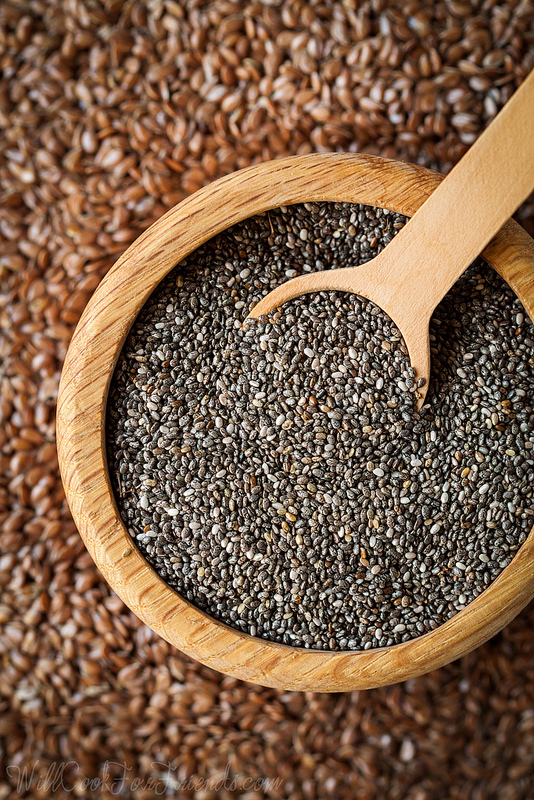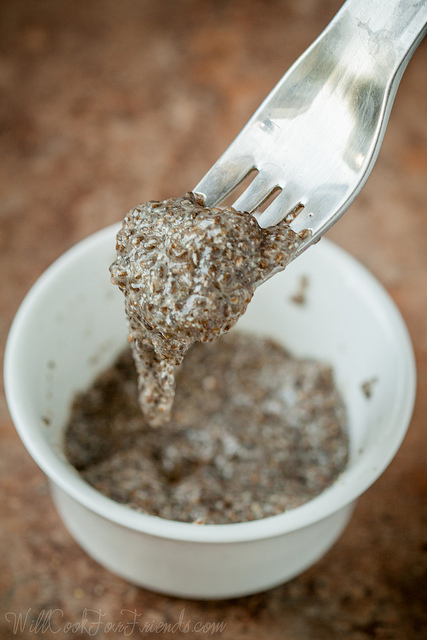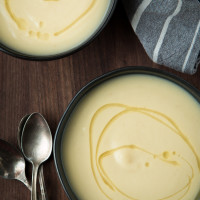As we all know, a flax egg is just like a regular egg only it comes from a flax chicken. Baby flax chickens, called flaxlings, grow up on a diet of… wait… what’s that? What do you mean there’s no such thing as a flax chicken?
Okay, scratch that.
A flax egg isn’t actually an egg at all. It is just a simple mixture of ground flax seeds and water, which gel into an egg-like consistency. Flax eggs are a popular substitute in vegan baking, and are a great alternative for anyone with allergies, too. I make a surprising amount of vegan treats (considering I’m not vegan myself), and I always prefer to use flax eggs over the mystery-carton of “egg substitute” found in the stores. Besides being easy to make and all-natural, the flax adds a bunch of healthy nutrients and omega-3 fatty acids, giving me an excuse to call whatever I’m making healthy.
The first time you mix some ground flax with water and watch it thicken you might think it’s magic, but how it works is really quite simple. Flax seeds contain long chains of starches which act as a hydrocolloid, meaning they bind to water to create a gel. Other common hydrocolloids include corn starch, tapioca, arrowroot, agar agar, xanthan gum, and carrageenan. This gel (also known as mucilage, if you want to be all sciency about it) works as a binder or emulsifier, and can be used in place of eggs in baking where the eggs are used to hold things together. In recipes which use eggs as foams, or to create leavening (such as angel-food cakes or souffles), flax would make a very poor substitute… for most cakes, cookies, breads, and muffins, however, this simple seed can do the job quite handily.
Flax, the incredible edible… egg?
But flax isn’t the only seed with this incredible thickening power. Enter, chia seeds.
If you aren’t familiar with them, chia seeds turn out to be good for a lot more than just growing “hair” on a chia-pet. These tiny little seeds pack just about as much omega-3 fatty acids, fiber, and protein as flax, without the sometimes oily, distinct flavor. I use chia seeds all the time for an added boost of nutrition — they can be sprinkled over salads, stirred into soup, used in place of poppy seeds, or added to smoothies or shakes. Because they have barely any flavor at all, they can be added to almost anything. I’ve even seen them used to make pudding, because like flax seeds, chia seeds have the same gelling properties.
So the question occurred to me… could I make a chia egg?
This week presented the perfect opportunity for experimenting, as I’ve been playing with a new recipe for vegan, gluten-free muffins. You’ll be seeing that recipe soon you can find them here, but first let’s take a look at how to make a standard flax egg.
Step one is to grind your flax seeds. You can buy pre-ground flax meal, but I don’t recommend it. Whole flax seeds can keep for a long time, especially if you store them in your fridge or freezer, but when flax is ground the oils are exposed to the air and can go rancid fairly quickly. Oils that have gone rancid are NOT good eats, and can impart an off flavor. Grinding your own isn’t hard, and it can be done with a spice grinder, a coffee grinder (I recommend having a separate grinder for your spices from the one you use for your coffee), or by hand with a mortar and pestle. If you bake frequently and don’t want to grind your seeds every time, you can grind up one bigger batch and keep it in an airtight container in the fridge or freezer for up to a few weeks.
A standard flax egg equals 1 TBSP ground flax seeds and 3 TBSP water. Keep in mind that 1 TBSP whole flax seeds will grind up into more than 1 TBSP flax meal. Go ahead and grind your seeds, then measure the amount you need.
I repeated these steps with chia seeds to see if they would perform the same way. Just like flax seeds, chia seeds are best ground fresh and stored in an airtight container in the fridge or freezer.
Much better!
Next I went ahead and tested each egg in a recipe. I split a batch of muffins, and made half with a flax egg and half with a chia egg. I compared the results with a separate batch made with regular eggs, then set myself to the grueling task of having to taste test all of them… and then taste them all again, just to be thorough… the things I do in the name of food…
 |
| Blueberry Almond Streusel Muffins |
After plenty of tasting and re-tasting, the results were in… and you know what? I could barely tell the difference! The muffins made with real eggs were slightly less dense than the ones made with flax or chia, but this was hardly noticeable enough to count against them. In terms of flavor, I found them to be completely indistinguishable. In recipes which call for a larger number of eggs, flax would have impacted the flavor more than the chia, but in this case neither were detectable… which is exactly what I had hoped for!
My other key finding is that muffins are delicious. I love learning, especially when it results in something tasty to eat.
The only down-side I can find to using chia seeds is that they are significantly more expensive than flax, but considering you only need half the amount per egg, that barely factors in. For me, chia seeds are more accessible than flax because I use them frequently, and always have them on hand.
So let’s review:
1 flax egg (equivalent to 1 regular egg) = 1 TBSP ground flax + 3 TBSP water
1 chia egg (equivalent to 1 regular egg) = 1/2 TBSP ground chia + 3 TBSP water
To make, grind your seeds first, then measure 1 TBSP (for flax) or 1/2 TBSP (for chia) into a small dish. Stir in 3 TBSP water, and let sit for 5-10 minutes to thicken. Can be used in most baking recipes which call for eggs as a binder.
What’s your favorite way to use flax or chia seeds? Let me know in the comments below!



















okay, so it’s early as i read this, and i was going right along with you about the flax chickens. then i stopped and was like “what? REALLY?!?!?!” and then i realized. duh.
i have never tried a flax/chia egg…i just read an article recently about a guy who has made some breakthrough in a very advanced “egg” like this, and it even looks like an egg, but it doesn’t scramble well. but inside things, it’s good. I think stuff like this is so awesome for vegan baking, but i’ll say: if you’re not vegan, i completely subscribe to the theory that eggs are like, the world’s most perfect protein. This is one of those things i would completely try just because i’ve become curious about vegan baking and all the science which goes into it.
viva la egg. or ovo,i guess. :)
Hahah, yep, I’ve been there! And I agree, real eggs are pretty incredible things – there’s so much you can do with them! I’ve heard a little about the new egg substitute they’re working on, but I don’t know a lot about it… frankly, I’m a little skeptical. I think for most of my baking needs, I’ll stick with a the flax or chia seeds, at least for now.
Loved your post ~ I’ve tried chia as an egg replacer before and it didn’t go well; however, now I know why ~ Thx for the scientific experiment & analysis :-)
Thanks, CJ – glad I could shed a little light on things!
Love this- I never have used chia as an egg sub in, thanks for doing all that hard taste testing for me!
Heheh, you’re welcome!
I really like this recipe but I have a couple of questions. I’m a cancer survivor and the worst thing for us is refined sugar (white or brown) so what do you suggest as an alternative to try. I am a vegan and I can’t do soy either. Thanks!
First of all, congratulations! That’s incredible, and it’s great to hear you’re looking out for your health.
Second, are you referring to the blueberry muffin recipe? It’s a little tricky to replace refined sugar in baking, because it can change the result so much. I haven’t tried making these particular muffins with anything besides sugar, but you could probably get decent results using something like coconut nectar or even maple syrup. You might even be able to use a little less than the sugar called for in the recipe, too. Using a syrup like that might make the muffins super moist or heavy, so you might want to reduce the amount of liquid (less almond milk). Again, I haven’t played around with it, so I can’t say for sure. I hope that helps!